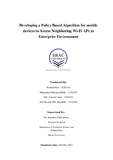Developing a policy based algorithm for mobile devices to access neighboring Wi-Fi APs in enterprise environment
Abstract
Wireless technology has been extensively used in every branch of life relating to internet usage. The AP acts as a central transmitter and receiver of wireless radio signals, which then usually connects to a hub, switch, or router via a wired network. Increasing the number of Wi-Fi access points provides network redundancy, better range, support for fast roaming and increased overall network-capacity by using more channels or by defining smaller cells. It has become so simple that any compatible device can connect to the Internet via a WLAN network and a wireless access point (AP). For that, in enterprise environment Wi-Fi system gets the priority for accessing the Internet. Enterprise environment is necessarily dependent on multiple access points (APs) because there is significant number of users and wide area to be covered efficiently. Often, it happens that a wireless device connected to a particular Access Point (AP) and accessing internet with that network, gets signal from other APs of neighborhood. And it is observed that at some point some neighborhood AP's signal strength is stronger than the signal strength of the AP it is connected to, and the device can get better Internet performance from the neighbor APs than its own Home AP. For this situation, or situation like this, it can be technologically and economically beneficial use any of neighbor networks. So, we developed an algorithm of two parts and created an application with that algorithm to allow the user to use AP from neighborhood with better internet performance.

